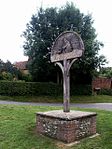Great Melton
AC with 0 elementsCivil parishes in NorfolkNorfolk geography stubsSouth NorfolkVillages in Norfolk

Great Melton is a civil parish in the English county of Norfolk. It covers an area of 10.24 km2 (3.95 sq mi) and had a population of 148 in 59 households at the 2001 census, increasing to 163 at the 2011 Census. For the purposes of local government, it falls within the district of South Norfolk. There is a local legend that the area is haunted by a phantom coach, containing four ladies in white.
Excerpt from the Wikipedia article Great Melton (License: CC BY-SA 3.0, Authors, Images).Great Melton
Hall Road, South Norfolk
Geographical coordinates (GPS) Address Nearby Places Show on map
Geographical coordinates (GPS)
| Latitude | Longitude |
|---|---|
| N 52.60771 ° | E 1.15237 ° |
Address
Hall Road
Hall Road
NR9 3BG South Norfolk
England, United Kingdom
Open on Google Maps








